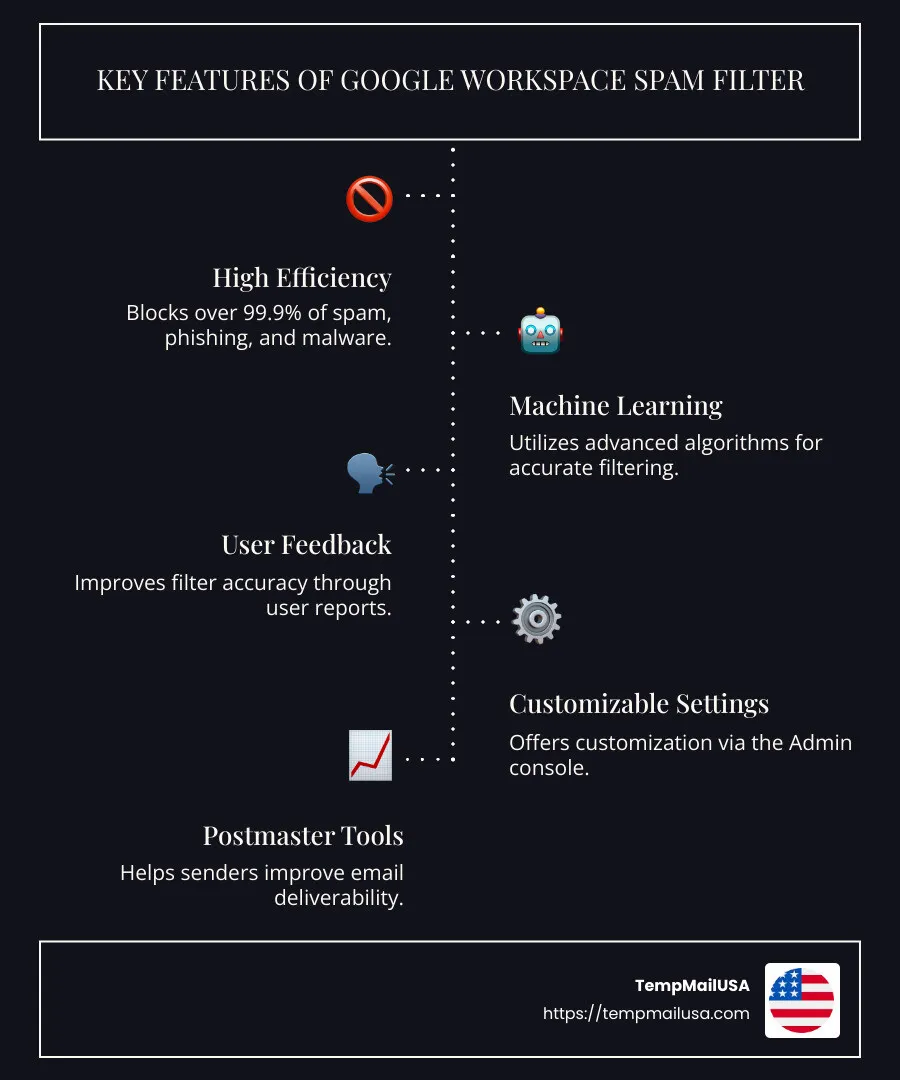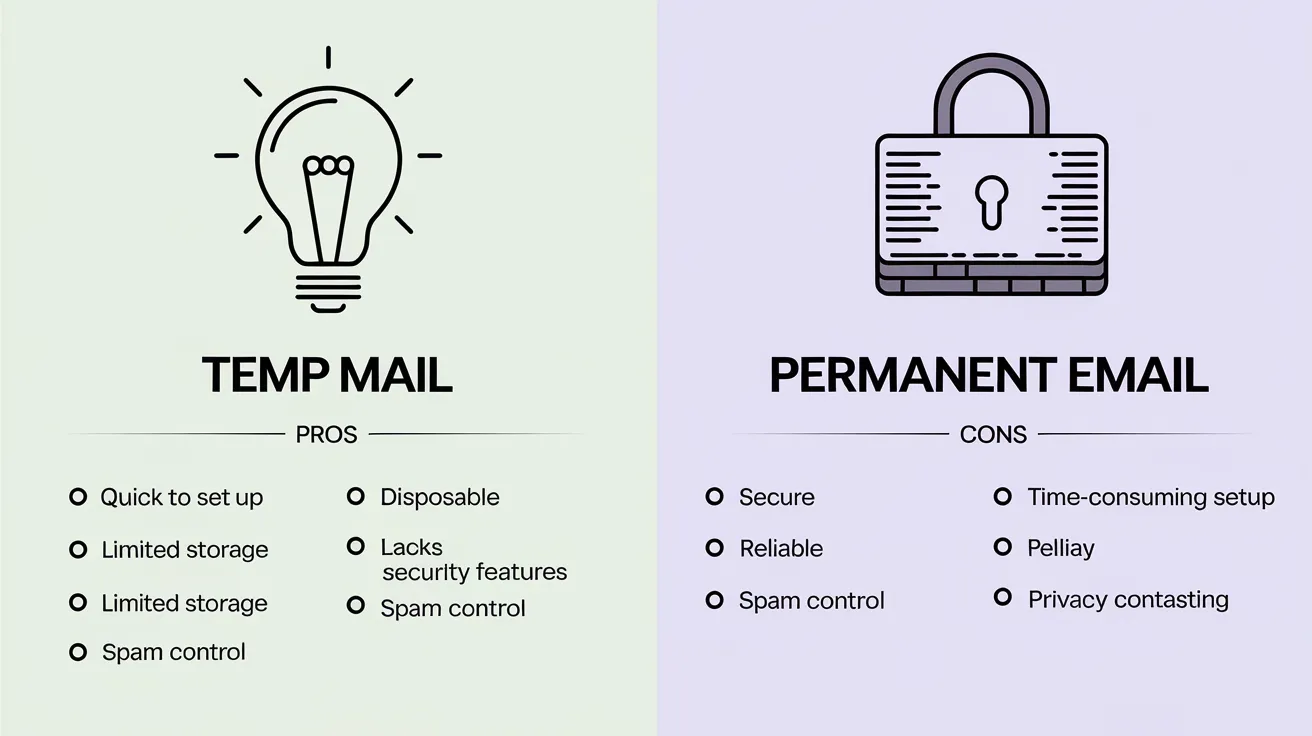
TempMailUSA's spam filter is a powerful tool designed to keep unwanted, dangerous, or unsolicited emails from cluttering your inbox. Whether you're a freelancer concerned about privacy or just someone tired of wading through spam, understanding how these filters work can be a game-changer for your email security.
- Blocks over 99.9% of spam, phishing, and malware
- Uses machine learning and user feedback for accuracy
- Offers customization through the Admin console
- Provides tools for better email delivery
Protecting your email is more important than ever. Spam isn't just annoying; it can also be a gateway for phishing attacks and malware that put your personal information at risk. Fortunately, TempMailUSA offers state-of-the-art spam filtering capabilities. These filters are backed by cutting-edge machine learning and user feedback, making them highly effective.
The tech-savvy freelancer or anyone valuing privacy will appreciate the ability to customize spam settings within TempMailUSA. From leveraging admin tools to ensuring email deliverability, TempMailUSA gives you control over your inbox. As a leading provider in email security, TempMailUSA's filtering system blocks more than 99.9% of spam, phishing, and malware, keeping users safe and productive.

Understanding Spam Filters
Spam filters are designed to keep your inbox free from unwanted and potentially harmful emails. These filters are powered by machine learning, which allows them to adapt and evolve based on new spam tactics and strategies. This adaptability is crucial in a digital landscape where spam techniques are constantly changing.
How do these filters work?
At the core of spam filters is a sophisticated machine learning system. This system analyzes vast amounts of data to identify patterns associated with spam. It considers various signals, such as IP addresses, domains, and whether the sender is authenticated. The goal is to distinguish between legitimate emails and those that are unsolicited, dangerous, or simply annoying.
But machine learning isn't the only tool in the arsenal. User feedback plays a pivotal role in refining these filters. Each time a user marks an email as spam or, conversely, indicates that a sender's emails are welcome, the filters learn and adjust. This feedback loop ensures the system remains effective and responsive to individual user preferences.

Machine Learning and User Input: A Dynamic Duo
Machine learning and user feedback work hand-in-hand to create a robust spam filtering system. While machine learning provides the backbone by identifying and adapting to spam patterns, user feedback fine-tunes the system to meet individual needs. This combination results in a highly personalized and efficient spam filter.
For bulk email senders, resources like Postmaster Tools can help improve email deliverability. These tools provide insights into domain health and other metrics, enabling senders to ensure their emails reach the intended recipients without being flagged as spam.
In summary, spam filters are a blend of advanced technology and user-driven insights. They offer a customizable, effective solution to keep your inbox safe and clutter-free.
Customizing Spam Settings in Your Email System
Managing spam effectively is crucial for maintaining a clean and efficient email system. While many email platforms have built-in spam filters, you can often customize these settings to better suit your needs.
Navigating Your Email Admin Console
To start customizing your spam settings, log in to your email admin console. From there, navigate to the section where you can manage spam, phishing, and malware settings. Here, you'll find a range of options to tweak how spam is handled.
Bypassing Spam Classification
One of the key features is the ability to bypass spam classification for specific senders. This is useful when you have trusted contacts or internal senders whose emails you want to ensure reach the inbox, not the spam folder.
- Approved Senders List: You can create a list of approved senders. Emails from these senders will skip the spam filter. This is ideal for ensuring important communications aren't missed.
- Internal Senders: You can also choose to bypass spam filters for messages sent within your domain. This ensures internal communications are not mistakenly flagged as spam.
Putting Spam in Quarantine
For more control, consider setting spam messages to be placed in quarantine. This allows you to review them before they reach users. It’s an excellent way to ensure no important emails are lost while still keeping spam at bay.
Additional Filter Options
- Aggressive Filtering: You can opt for more aggressive filtering, which increases the likelihood of emails being marked as spam. This can be useful for domains that receive a lot of junk mail.
- Custom Filters: You can add custom filters based on specific criteria you define. This helps in tailoring the spam settings to match your organization's unique needs.
By using these features, you can effectively manage spam and ensure that your users’ inboxes remain clutter-free. Whether it's bypassing spam filters for trusted senders or reviewing quarantined emails, your email system provides the tools you need to handle spam like a pro.
Advanced Spam Filtering Techniques
Enhancing your spam filter involves using advanced techniques like whitelisting, improved scanning, and setting up an inbound gateway. These methods offer you greater control over what lands in users' inboxes and what gets filtered out.
Whitelisting: Keeping Trusted Senders in Your Inbox
Whitelisting is a powerful tool that ensures important emails from trusted sources never get marked as spam. In your email system, you can whitelist by:
- Email Address: Add specific email addresses to your whitelist to guarantee their messages always reach the inbox.
- Domain: Whitelist entire domains, ensuring emails from all addresses within that domain bypass spam filters.
- IP Address: Include IP addresses in your whitelist to avoid blocking emails sent from trusted servers.
Whitelisting is especially useful for maintaining seamless communication with partners and clients. By listing their domains or addresses, you prevent false positives where legitimate emails are incorrectly tagged as spam.
Improved Pre-Delivery Message Scanning
For organizations needing extra vigilance, your email system offers improved pre-delivery message scanning. This feature adds an extra layer of scrutiny to incoming emails, especially those that appear suspicious.
- Delayed Delivery: When enabled, this feature introduces a short delay in message delivery. This allows for an additional scan to detect phishing attempts or other threats.
This improved scanning is particularly beneficial for identifying and mitigating sophisticated phishing attacks that might otherwise slip through standard filters.
Inbound Gateway: First Line of Defense
Setting up an inbound gateway acts as a preliminary checkpoint for all incoming emails. It's like having a security guard at the entrance before emails even reach your servers.
- MX Records Configuration: You need to configure your domain's MX records to point to the inbound gateway. This ensures all emails pass through this initial filter.
- Advanced Filtering: The inbound gateway can be set to perform additional filtering and archival tasks, adding another layer of protection against spam and malware.
By utilizing an inbound gateway, you can filter out unwanted emails at the server level, which helps in reducing the load on your spam filters and ensures that only clean emails reach your users.
These advanced techniques not only improve your spam filtering capabilities but also provide a robust framework for email security within your organization. By implementing whitelisting, improved scanning, and an inbound gateway, you can significantly reduce spam and safeguard your users' inboxes against threats.
Frequently Asked Questions about Google Workspace Spam Filter
How do I stop spam in Google Workspace?
Managing spam in Google Workspace starts with using the Admin console to customize your spam filter settings. You can create a custom spam filter to ensure that messages from trusted senders are not marked as spam. This involves:
- Bypassing Filters for Approved Senders: Add specific email addresses or domains to an approved list. This ensures their emails reach the inbox without being flagged as spam.
- Quarantine Spam Messages: Set up a system where suspicious messages are held in quarantine. This allows you to review them before they reach the users.
- Adjust Spam Sensitivity: Increase the aggressiveness of spam filtering to catch more unwanted emails, or dial it back if too many legitimate emails are being marked as spam.
Does Gmail have a good spam filter?
Yes, Gmail's spam filter is highly effective, blocking over 99.9% of spam, phishing, and malware from reaching users' inboxes. This is achieved through a combination of machine learning and user feedback. Here's how it works:
- Machine Learning: Gmail's filters learn from vast data sets to identify and block new spam tactics. They continuously adapt to evolving threats.
- User Feedback: When users mark emails as spam or move them back to the inbox, Gmail's filters learn and adjust accordingly. This feedback loop helps improve accuracy and effectiveness.
How can senders improve email deliverability?
Improving email deliverability is crucial for senders who want their messages to reach the intended recipients. Here are some best practices:
- Use Postmaster Tools: Google offers the Postmaster Tools to help bulk senders monitor the health of their domains. This tool provides insights into how emails are being delivered and any issues that need addressing.
- Authenticate Emails: Ensure that your emails are authenticated using SPF, DKIM, and DMARC. This helps Gmail recognize your emails as legitimate and reduces the chances of them being marked as spam.
- Follow Sending Best Practices: Avoid sending too many emails at once, maintain a clean mailing list by removing inactive addresses, and ensure the content of your emails is relevant and valuable to recipients.
By using these strategies, senders can increase the likelihood that their emails will successfully reach users' inboxes without being caught by the spam filter.
Conclusion
In today's digital landscape, email privacy and spam protection are more important than ever. With the rise of unwanted messages and potential threats, having robust solutions to manage and filter emails is crucial.
TempMailUSA offers a practical solution by providing disposable temporary email services. This allows users to keep their real email addresses private and free from spam. By generating temporary emails effortlessly, users can protect their inboxes from unwanted messages and potential security threats.
The Google Workspace spam filter is a powerful tool in the fight against spam. With its machine learning capabilities and user feedback mechanisms, it blocks over 99.9% of spam, phishing, and malware. This ensures that users receive only the messages they want, while keeping their personal information secure.
For those looking to improve their email security, TempMailUSA provides a seamless way to manage online privacy. By using temporary emails, users can enjoy a clutter-free inbox and peace of mind knowing their information is protected.
Explore more about how TempMailUSA can help you safeguard your online safety here.




